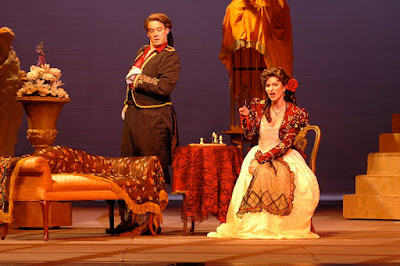- The opera was based on a play called The Barber of Seville by Pierre Beaumarchais. Beaumarchais also wrote a sequel called The Marriage of Figaro, upon which Mozart's opera of the same name was based.
- Gioachino Rossini was 23 when he was commissioned to write it by the Teatro Argentina. Rossini was known for writing operas very quickly - he completed it in three weeks.
- However, he did cheat a little - he re-used some music from a couple of operas he'd written earlier, Aureliano in Palmira and Elisabetta, regina d'Inghilterra, for the overture.
- He wasn't the first composer to write an opera based on the play by Beaumarchais. Giovanni Paisiello had also written one, so originally, Rossini called his own version Almaviva after one of the characters in it. Only after Paisiello had died did Rossini's opera become known as The Barber of Seville.
- The premiere, on 20 February 1816 in Rome was not a success. Not only were there any number of first night mishaps, including a Cat wandering onto the stage, the audience included a bunch of Paisiello's fans, who weren't happy that Rossini had written a new opera based on the same play. They made their disapproval obvious by booing.
- On the second night, Rossini was so upset by the reaction of the first night audience that he refused to come out of his room to attend the performance. However, without the disruptive influence of the Paisiello fans, this audience loved it. They loved it so much that a crowd of them went to Rossini's house to cheer him.
- It is from this opera that one of the best known arias comes - Largo al factotum, in which the character Figaro repeats his own name, not from Marriage of Figaro, although it's an easy mistake to make since Figaro is a central character in both.
- Rossini wrote the music but the libretto was written by Cesare Sterbini. It would be translated into English a couple of years later by John Fawcett and Daniel Terry.
- So what's the story? The beautiful Rosina is the ward of a grumpy old man called Dr Bartolo, who wants to marry her. Also in love with her is a young count, Almaviva, who saw her in Madrid and has come to seranade her. At first, Rosina doesn't appear and the count is about to give up when Figaro arrives on the scene. Figaro is an employee of Bartolo, performing a range of roles from barber to surgeon to wigmaker to herbalist. Figaro agrees to help the count, for a fee. He suggests the count pretends to be a drunken soldier who is to be billeted at the house. When Bartolo goes out, the count seranades Rosina again and this time, she comes out to listen and falls in love with the singer before the servants drag her back indoors. Bartolo returns and with Don Basilio, Rosina’s music teacher, starts writing up a marriage contract. He knows Rosina is in love with someone else and so is eager to marry her as soon as possible. The Count shows up pretending to be a drunken soldier, only to be told that Bartolo is exempt from the law requiring people to billet soldiers. The police are called to arrest the drunken soldier, but they let him go when he tells them he is really the Count.
- In the second act, the Count disguises himself as a Music teacher, sent in place of Basilio, who is ill. Rosina comes in and she and the Count sing an aria together. Bartolo doesn't like it, and sings Rosina a song of his own, pretending to be another famous singer, but he's not very good. Figaro arrives and announces it's time for Bartolo's shave. Bartolo gives him his keys so he can get the shaving things. He pretends to break some china, to distract Bartolo while he slips the balcony keys to the Count. At which point, the real music teacher shows up, wondering what on Earth is going on. Figaro and the Count persuade him (with a little money) that he is ill and needs to go home to bed. Figaro gives Bartolo a shave while the Count and Rosina plan to elope. Bartolo, however, manages to convince Rosina that the "music teacher" is in love with another woman and he intends to sell her to Count Almaviva. So when the Count shows up to elope with her, she at first refuses, accusing her of betrayal. He tells her that he is the Count and she agrees to run away with him, only to find someone has removed the ladder from the balcony. The notary shows up to perform the marriage of Rosina to Bartolo, but is persuaded by Figaro to marry her to the Count instead. Bartolo arrives with a police officer whereupon the Count reveals his identity to everyone.
I write fiction, too! My characters include some British superheroes and a psychic detective. You never know, your new favourite could be here! You won't know unless you look...
Browse other topics I've covered in this blog - HERE.
Like my Facebook page for news of Topical Ten posts, posts on my writing blog, and news of upcoming publications. |


No comments:
Post a Comment